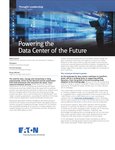Amazon says all of its operations – including its data centers – are now powered by renewable energy.
Amazon set a goal in 2019 to match all of the electricity consumed across its global operations – including data centers, corporate buildings, grocery stores ,and fulfillment centers – with 100 percent renewable energy by 2030.
The company this week announced it has met that goal seven years early – matching all operations with renewable energy in 2023.
“Reaching our renewable energy goal is an incredible achievement, and we’re proud of the work we’ve done to get here, seven years early. We also know that this is just a moment in time, and our work to decarbonize our operations will not always be the same each year - we’ll continue to make progress, while also constantly evolving on our path to 2040,” said Amazon's chief sustainability officer, Kara Hurst.
“Our teams will remain ambitious, and continue to do what is right for our business, our customers, and the planet. That’s why we’ll continue investing in solar and wind projects, while also supporting other forms of carbon-free energy, like nuclear, battery storage, and emerging technologies that can help power our operations for decades to come.”
According to Bloomberg NEF, Amazon has been the largest corporate purchaser of renewable energy in the world for four years running. The company has invested in more than 500 solar and wind projects across 27 countries globally, more than half of which are on-site rooftop solar.
Amazon has not yet announced plans to move to a 24/7 matching model, where every minute of energy use at its facilities is matched with renewable power during times of low wind and solar generation.
Amazon aims to reach net-zero carbon by 2040.
Amazon releases ESG report: Scope 1 emissions up
This week saw Amazon release its 2023 sustainability report.
Overall, the company saw its Scope 1 emissions rise from 13.32 million metric tons carbon dioxide equivalent (MT CO2e) to 14.27m. Scope 2 emissions dropped from 3.14m MT CO2e to 2.79m, and Scope 3 drop from 54.28m to 51.76m.
In the report, Amazon said it has a total of 513 renewable energy projects totaling 28GW – up from 20GW in 2022; 243 of those were utility-scale wind and solar projects.
In the report, Amazon described Nuclear energy as “a strong option that already has a proven track record of providing a constant source of reliable power for communities around the world.” Earlier this year the company purchased a nuclear-powered data center in Pennsylvania, US, from energy company Talen, and plans to build out the site utilizing power provided by Talen's adjacent nuclear power station.
Notable efforts in the report include Amazon’s efforts to reduce the amount of embedded carbon in its data center construction projects. AWS has reduced steel content by 70 tons for each two-story data center and 137 tons for each three-story data center, decreasing emissions by 63 and 124 metric tons of CO2e, respectively. In 2023, AWS built 31 data centers with lower-carbon steel, up from 10 in 2022.
In 2023, AWS built 36 data centers with lower-carbon concrete, up from 16 in 2022. AWS also tested a low-carbon, performance-based ASTM C1157 Hydraulic Cement by concrete supplier Ozinga, which achieved a 64 percent reduction in embodied carbon compared to ‘the industry average.’
Amazon has pledged to be water-positive by 2030. Over 2023, the company’s data centers operated at 0.18 liters of water per kilowatt-hour (L/kWh) water use effectiveness (WUE) for AWS data centers, a 5 percent improvement from 2022 and a 28 percent improvement from 2021.
“In 2023, AWS installed thousands of sensors in its data centers to track water us,” the company said. “Automatic alerts inform AWS of any anomalies so that operators can investigate in near-real time. AWS also invested in on-site water treatment systems that remove scale-forming minerals and allow AWS to recycle more water on-site and minimize the water consumed for cooling.”
In 2023, AWS said it increased the number of data centers using recycled water for cooling from 20 to 24, including two data centers in Virginia, one in California, and one in Singapore. In Brazil, two of its data centers collect rainwater.






